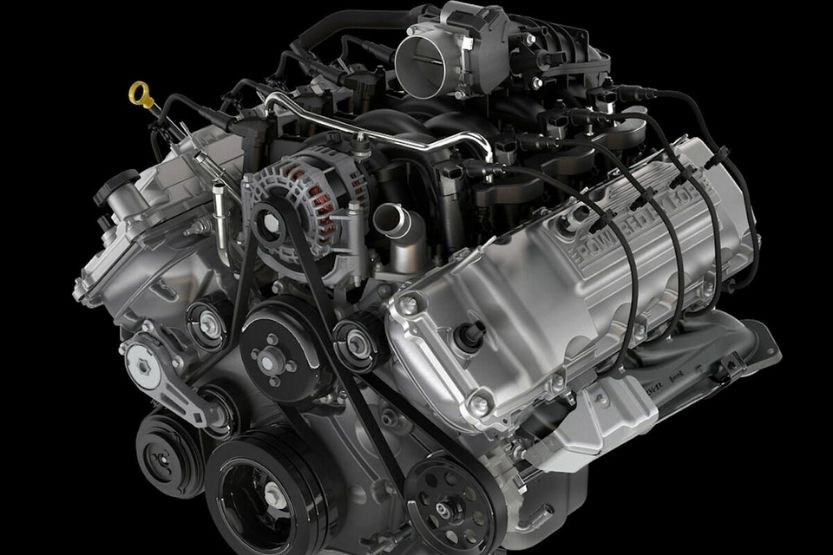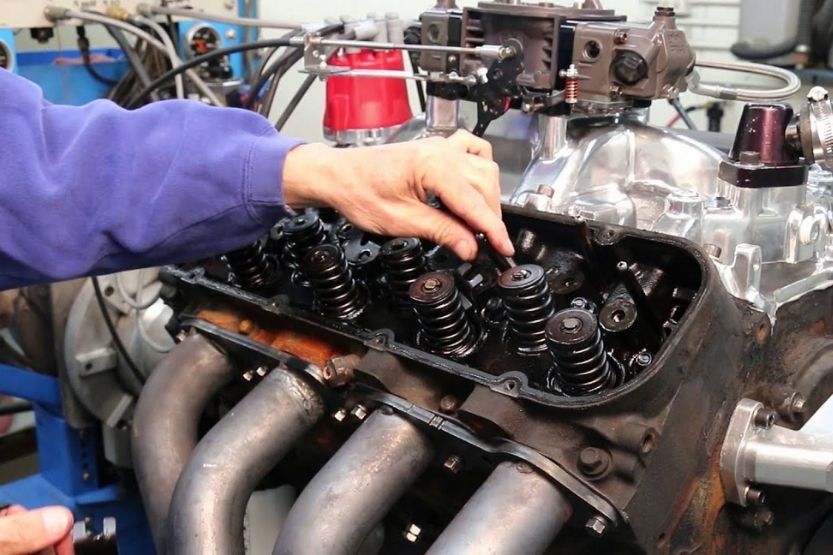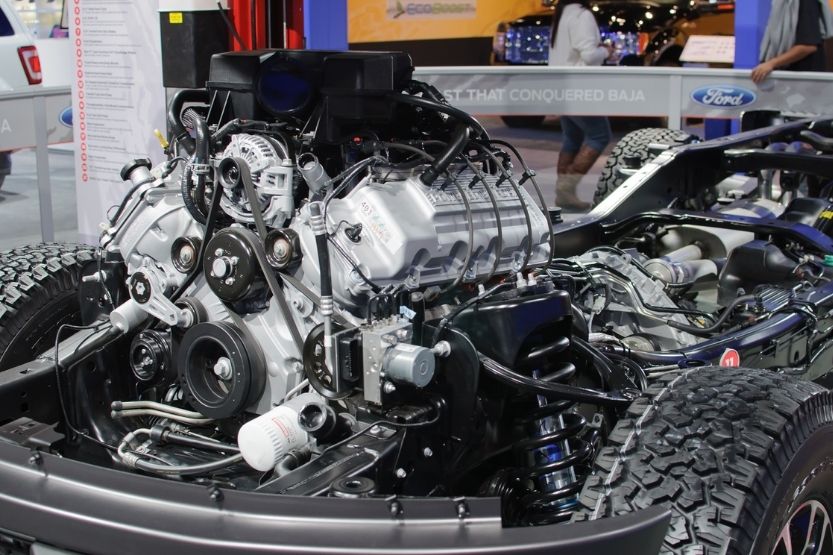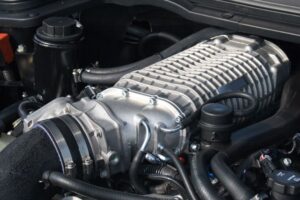The Ford 6.2 engine has been a widely-used and reliable engine for Ford’s big V8 trucks. However, like any engine, it can run into problems over time. So, what are the possible Ford 6.2 Engine problems?
The 5 most common problems of the Ford 6.2 engine include the following:
- Rough Idle
- Valve Spring Failures
- High Oil Consumption
- Oil Leak Problems
- Vacuum Leak
With that said, this engine is still pretty reliable. There are vehicles with these engines still running for over 300,000 to 400,000 miles with minimal problems.
Ford Motor introduced its 6.2-liter engine in 2011. This engine was used as the motive power for big Ford trucks. If an owner treats their truck right, this engine will last more than guaranteed by its manufacturer. However, problems
Read on to learn more about the common problems of the Ford 6.2 engine and how to fix these problems.
Ford 6.2 Engine Problems

Like any other engine that powers cars, trucks, buses, and even ships, the Ford 6.2 engine has its share of issues. Some of the most common problems experienced by this engine are the following:
- Rough idling
- Failures in its valve springs
- Above-average oil consumption
- Engine oil leaks
- Leaks in its vacuum system
Despite these Ford 6.2 liter gas engine problems, this engine is still very reliable. Some of the vehicles powered by this engine are still running with their odometers already reading 300,000 miles, with some even reading 400,000 miles.
Ford Motors launched this engine in 2011. It powered Ford’s Super Duty pickups and replaced two engines, namely the 6.8L Triton V10 and the 5.4L Triton V8. This engine was the premium engine option of the Ford F-150. But it was not available in all of its variants.
Before it powered some of its heavy-duty truck models, Ford Motor Co. has subjected this engine to torturous tests to prove its strength and durability. But that doesn’t mean that it is totally bulletproof. Now and then, issues may arise which give headaches to their owners.
This engine is being replaced by a newer engine, the 7.3-liter V8 gas engine. But Ford is still selling 6.2-liter V8 engines in a new Super Duty version. New or used Ford F-150s have these engines.
If you own or plan to buy this truck, you need to read the rest of this article. This will increase your awareness of the potential problems you may encounter with the vehicle and help you prepare for them in advance.
1. Rough Idling
Rough idling is actually a symptom of an underlying problem. It appears that the 6.2L V8 engine commonly manifests this symptom. Some reviewers believe that the engine’s spark plugs may partly cause this.
You might be surprised to know that this engine has a total of 16 spark plugs. This engine uses two spark plugs for each of its 8 cylinders. With this whopping number of cylinders, it will not be too far out to think that there are plenty of chances for engine misfires.
Fortunately, spark plug misfires are not a true problem. It can be solved by regular spark plug maintenance. Remember that the F-150 is a tough truck and is used for tough jobs. True problems are those that cause a heavy on your pocket.
So, having 16 spark plugs initiating the combustion cycle is pretty much complicated in terms of perfect timing. Just one spark plug misfiring will cause a rough ride. What more if you have two of them misfiring? But don’t worry. Multiple spark plugs rarely fail at the same time.
Are there warning signs that the spark plugs in your 6.2-liter engine are having problems?
Symptoms That Indicate Potential Spark Plug Problems
- Stuttering or hesitation
- Loss of power
- Misfires
- Rough idling
Professional car mechanics say that if you have been using your truck for a long time, it is best to replace all the spark plugs at the same time if one is found to be defective. Of course, if your truck is relatively new and just one spark plug is at fault, replace that one bad spark plug.
Spark plugs usually come at $7 to $15 apiece. With 16 sparks, you will need from $100 to $150 to replace them all. This is a job that you can certainly do. However, if you ask a car service shop to do it, you may add from $50 to $150 on top of the spark plug cost.
2. Valve Spring Failures

Valve springs are inside the cylinder heads and around the valve stems. They use pressure to control the intake and exhaust valves and prevent them from bouncing and floating. There is a valve spring in every valve. Since the 6.2L engine has 16 valves, therefore it also has 16 valve springs.
Bad valve springs, sad to say, is one of the common problems of the 6.2L engine. If one valve spring goes bad, it will trigger all other engine issues. The engine will start throwing misfire codes, run rough, and so forth.
If valve spring failure is found to be the problem, you must correct it at once. If not, it will result in further damage to the engine. What are the signs that will show you that the engine’s valve springs are malfunctioning?
Symptoms
- Knocking sounds
- Loss of power
- Misfiring
- Rough idling
Some say that this valve spring issue may crop up when your truck has already logged in about 100,000 miles on the odometer. You don’t need to be shocked when this issue suddenly appears. Just watch out for the signs mentioned above so you can prepare.
Replacing the bad valve springs will fix the issue. But to replace a faulty spring, you have to remove its valve cover. This job is not really super complicated. But you can’t do it if you don’t have the tools and the rudimentary skills. Just give your car to the professional so they can fix it professionally.
The cost of a valve spring is really cheap. One spring will cost from $4 to $6. So, for a complete set, you will need from $60 to $80. It is in the cost of labor where you will be hit. Professional mechanics typically charge from $300 to $700 to do valve spring replacements. If your engine already has high mileage, you are in for a full set replacement.
3. High Engine Oil Consumption
The Ford 6.2L V8 engine has a reputation for being an engine oil guzzler. Compared to other engines of its size and class, this 6.2L Ford engine beats them all when consuming oil at a fast rate. Some owners find that they need to top the oil up by one quart or even two quarts between their oil changes.
One reason it consumes engine oil faster is its positive crankcase ventilation (PCV) system. If there are small openings in its valve cover gaskets, oil leaks may also cause loss of engine oil which translates to high consumption. However, this issue will not result in any major engine problem.
This problem is more common to engines with high mileages. Their cylinders are probably losing compression, so they are burning more oil. It could be a sign that these engines are already approaching the end of their lives. If your engine’s odometer reads between 200,000 and 250,000 miles, this issue will start to crop up.
Prevention
- Follow a shorter oil change interval, meaning change the engine oil more frequently than before. Engine oil gets thinner as it gets older. Old engine oil increases the chances of high consumption and oil blow-by.
- Regularly service the engine’s PCV system.
- Don’t idle your engine too much.
- Check for engine oil leaks regularly.
4. Oil Leak Issues

When an engine clocks in high mileage, it begins to wear out. Internal combustion engines are subjected to tremendous heat and pressure, both of which take a toll on their delicate parts. So, older engines are usually the ones that develop oil leak problems.
Some of the Ford 6.2 liter gas engine problems stem from the valve cover gaskets. There are 6.2L engines that develop leaks on the right side valve cover, particularly in its baffle. Ford issued a TSB (technical service bulletin) in this regard to address this issue.
This problem can also be triggered by the main seals as well as the oil pan gaskets. But many industry analysts say that this is truly not a very common problem on this 6.2L Ford engine. It is only natural for gaskets to deteriorate and then leak throughout the engine’s life.
There are really no design flaws in this engine that will cause oil leaks. Even then, it is not unusual for 6.2L engines that are more than 100,000 miles to experience this issue. But some symptoms will warn you about its development.
Symptoms
- The smell of burning oil
- Smoke on the engine bay
- Loss of engine oil
- Visible oil leaks
This issue is relatively easy to fix, but the cost of repair is a bit expensive. The gaskets are inexpensive, but the labor is high. If you have moderate DIY skills, you may be able to do it. Otherwise, you need $200 to $500 to fix this issue fixed by a professional mechanic.
5. Vacuum Leak
A vacuum leak will cause damage to your engine if you don’t address it right away. If you hear hissing sounds from the engine bay, there may be a vacuum leak in your system. You can basically determine if there’s a vacuum leak in your car by doing the following:
- Open the car’s hood.
- Go near the engine. If you hear a hissing sound, there is a vacuum leak.
Pinpointing the exact location of the leak is something that weekend mechanics usually cannot perform easily. This is a job that professionals should only do. Qualified mechanics typically use smoke machines to pinpoint the exact spot where the leak is.
Sadly, these machines are expensive. Usually, only car service shops and professional car mechanics have these machines. It will be unwise for you to spend a lot of money to spot one vacuum leak.
If you don’t want to pay for the service, there is a way to do it yourself. You can use a trick that will show you if the problem is really a vacuum leak.
How to Determine If Your Engine Has a Vacuum Leak
- Prepare a new hose, a cigar, and a lighter.
- Be sure that the engine is cold before you start to trace the source of the leak.
- Get near the spot where you think the leak is coming from and remove the vacuum hose.
- Place a new hose where you have just removed the previous hose. (This means that you have to prepare this new hose before removing the existing hose from its place).
- Use the lighter to light up the cigar. The cigar should start to produce smoke.
- Blow the smoke from the cigar into the hose.
- Observe the engine. Find out where the smoke you just blew into the hose went to.
- Once you find where the smoke went, remove the new hose and put back the previous hose in its place. This is the hose that is causing the vacuum leak. Make sure that you fixed it so it won’t cause any more vacuum leaks.
If you are not a smoker, you can try a vaping device. It will do just as well. This smoking process is straightforward. It will not take too much time to perform.
How Reliable Is the 5.0 Coyote F150 Engine?
Conclusion: Ford 6.2 Liter Gas Engine Problems
The most common problems of the Ford 6.2 engine include the following:
- Rough Idle
- Valve Spring Failures
- High Oil Consumption
- Oil Leak Problems
- Vacuum Leak
While this engine has these common problems, it cannot be denied that it is still a pretty reliable engine. Many vehicles powered by this engine are still running today for more than 300,000 to 400,000 miles without encountering major problems.
Related reading:

![5.7 Hemi Problems [7 Most Common] 5.7 Hemi Problems](https://roadsumo.com/wp-content/uploads/2021/11/5.7-Hemi-Problems-150x150.jpg)


![Why Is My ABS Light On? [7 Common Reasons] why is my abs light on](https://roadsumo.com/wp-content/uploads/2022/04/why-is-my-ABS-light-on-150x150.jpg)
![Most Reliable Sports Cars in the World [Top 10] most reliable sports cars in the world](https://roadsumo.com/wp-content/uploads/2022/10/most-reliable-sports-cars-in-the-world-150x150.jpg)
![Most Reliable Luxury Cars [Top 10] most reliable luxury cars](https://roadsumo.com/wp-content/uploads/2022/10/most-reliable-luxury-cars-150x150.jpg)

![Read more about the article Duramax Years to Avoid [Worst Duramax Engines]](https://roadsumo.com/wp-content/uploads/2022/05/Duramax-years-to-avoid-300x200.jpg)
